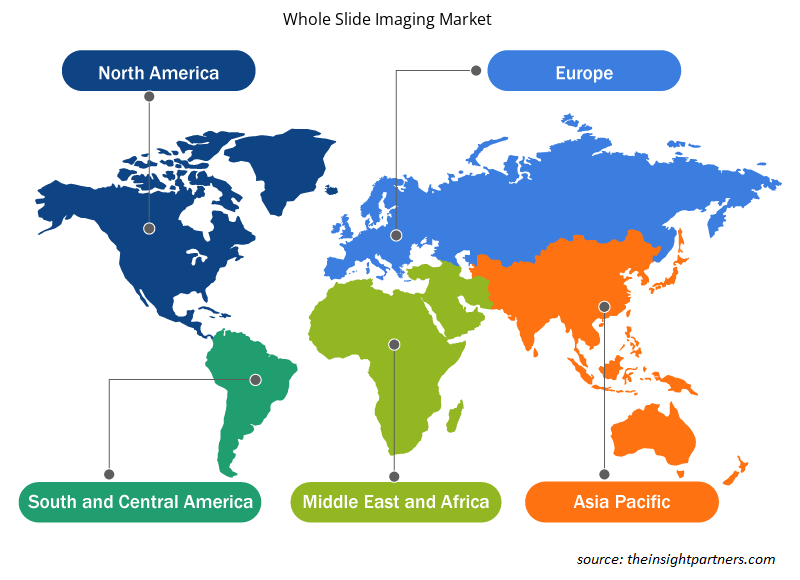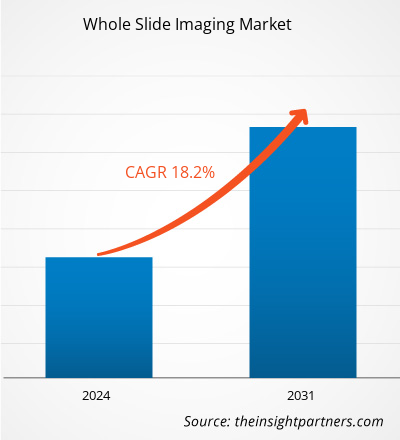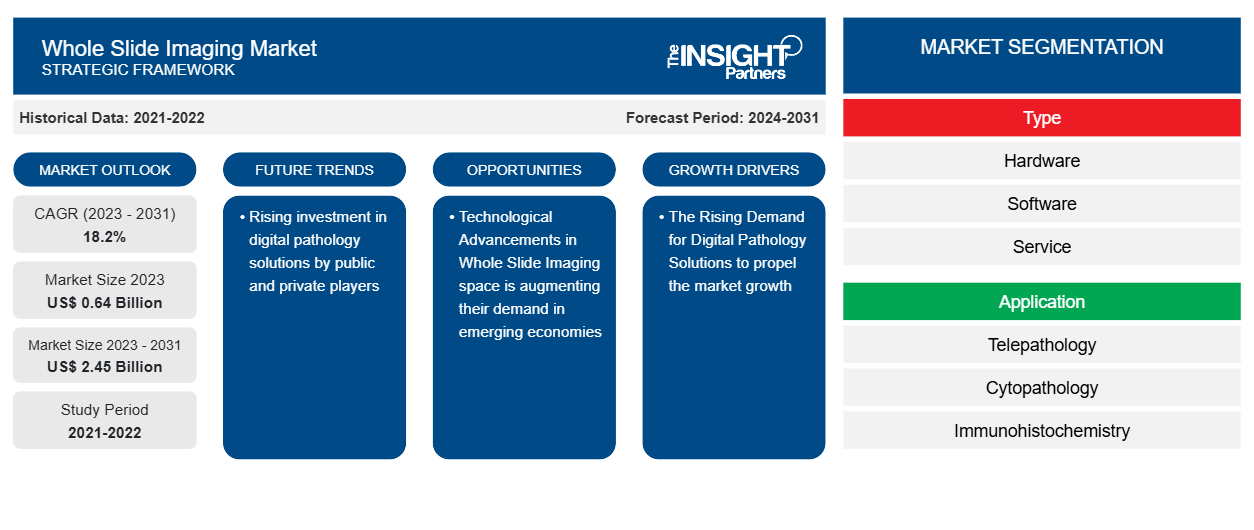Le marché de l'imagerie par diapositives devrait atteindre 2,45 milliards USD d'ici 2031, contre 0,64 milliard USD en 2023. Le marché devrait enregistrer un TCAC de 18,20 % au cours de la période 2023-2031. L'utilisation de l'intelligence artificielle pour un meilleur traitement et de meilleurs résultats devrait rester une tendance clé du marché.
Analyse du marché de l'imagerie par diapositives complètes
L'imagerie de lames entières est le processus de numérisation et de stockage sous forme d'images numériques d'une lame de tissu contenant de fines sections d'échantillons de tissu pour une inspection microscopique. Cette procédure permet une analyse et une collaboration à distance en tenant compte de la rapidité, de la facilité d'utilisation et de la qualité de l'image. Le besoin de traitements de pointe et l'incidence croissante des maladies chroniques entraîneront probablement une augmentation du nombre d' installations de recherche et du financement dans ce domaine. On prévoit que ces investissements présenteront une opportunité rentable d'expansion du marché. Pour les chercheurs, l'imagerie de lames entières offre de nombreux avantages, notamment une efficacité améliorée du flux de travail de pathologie et un examen et une analyse à distance. Par conséquent, le marché devrait croître en raison de l'augmentation significative des investissements dans la recherche et le développement réalisés par les agences gouvernementales et les acteurs de l'industrie.
Aperçu du marché de l'imagerie de diapositives complètes
L'accent mis sur l'obtention de résultats diagnostiques supérieurs accroît considérablement le besoin de pathologie numérique. Les plus grandes entreprises de pathologie du pays, les centres de santé universitaires et les services de pathologie partagent tous une acceptation croissante de la pathologie numérique et de l'imagerie sur lame entière. Aux États-Unis, un grand nombre de groupes de pathologie en pratique privée reconnaissent que la pathologie numérique représente l'avenir du domaine dans son ensemble. La majorité des grandes sociétés de laboratoire de pathologie et des services de pathologie universitaires ont intégré l'imagerie sur lame entière (WSI) et la pathologie numérique (DP) dans de nombreuses opérations de routine de leur laboratoire. En conséquence, les principaux acteurs se concentrent sur l'introduction de nouveaux produits. Tout d'abord, la société Bruker Canopy Biosciences a annoncé le lancement de la chambre d'imagerie sur lame entière CellScape, qui apportera la biologie spatiale sur lame entière à la plate-forme adaptable CellScape Precise Spatial Multiplexing en avril 2024. Avec une surface d'imagerie totale de 710 mm2, la nouvelle chambre d'imagerie possède la plus grande fenêtre de tous les instruments de biologie spatiale microfluidique du marché. De plus, la nouvelle chambre d'imagerie permet une diminution générale des volumes de réactifs nécessaires pour chaque échantillon. L'imagerie de lames entières devrait devenir plus populaire en raison de la demande croissante de solutions de pathologie numérique ; cela propulsera finalement le marché au cours de la période projetée.
Personnalisez ce rapport en fonction de vos besoins
Vous bénéficierez d'une personnalisation gratuite de n'importe quel rapport, y compris de certaines parties de ce rapport, d'une analyse au niveau des pays, d'un pack de données Excel, ainsi que de superbes offres et réductions pour les start-ups et les universités.
-
Obtenez les principales tendances clés du marché de ce rapport.Cet échantillon GRATUIT comprendra une analyse de données, allant des tendances du marché aux estimations et prévisions.
Facteurs moteurs et opportunités du marché de l'imagerie de diapositives entières
Les avancées technologiques dans l'imagerie de lames entières favorisent la croissance du marché
À la fin des années 1990, l'imagerie de lames entières est devenue populaire. La phase initiale du système consistait à prendre des photos de lames composites à l'aide d'une combinaison d'un microscope et d'un ordinateur. En revanche, l'acquisition d'images du système prenait beaucoup de temps. Les entreprises technologiques ont utilisé des systèmes à grande vitesse et des algorithmes automatisés pour augmenter la vitesse d'acquisition des images afin de contourner cette restriction. Grâce à cette avancée technologique, l'imagerie de lames entières a davantage d'applications. Par exemple, en mai 2021, le College of American Pathologists (CAP), en partenariat avec l'American Society for Clinical Pathology (ASCP) et l'Association for Pathology Informatics (API), a mis à jour la directive « Validation de l'imagerie de lames entières à des fins de diagnostic en pathologie » en réponse aux progrès rapides réalisés dans les applications cliniques de l'imagerie de lames entières et de la pathologie numérique. Grâce aux nouvelles directives, les patients auront la garantie d'un diagnostic pathologique rapide et de résultats de test de haute qualité, ce qui pourrait conduire à un traitement plus précoce. Les technologies d'imagerie de lames entières évoluent positivement grâce aux améliorations continues des algorithmes de calcul et des technologies de capture d'images. Cette technologie améliore le débit, réduit les erreurs et permet une capture, un archivage et un partage d'images rapides et efficaces. Par exemple, Inspirata Inc. a annoncé en mars 2022 que le logiciel de pathologie numérique Dvnamyx avait reçu l'autorisation de la FDA (Food and Drug Administration) aux États-Unis. Avec plusieurs scanners, Dvnamvx est la première entreprise à recevoir l'autorisation de la FDA pour un logiciel de pathologie numérique, permettant aux clients de choisir les meilleurs scanners pour leur laboratoire. Grâce à cette autorisation, les clients de Dvnamyx peuvent utiliser des images de lames entières (WSI) plutôt que des lames de verre conventionnelles pour le diagnostic primaire, ce qui présente des avantages significatifs pour les laboratoires et les pathologistes. Selon les estimations, ces avancées technologiques encourageront l'utilisation de systèmes d'imagerie de lames entières, ce qui accélérera à terme l'expansion du marché tout au long de la période de prévision.ASCP) and the Association for Pathology Informatics (API), updated the guideline "Validating Whole Slide Imaging for Diagnostic Purposes in Pathology" in response to the swift progress being made in clinical applications for whole slide imaging and digital pathology. With the new guidelines, patients will be guaranteed a speedy pathologic diagnosis and high-quality test results, potentially leading to earlier treatment. Whole slide imaging technologies are developing positively as a result of ongoing improvements in computational algorithms and image capture technologies. This technology is improving throughput, reducing errors, and enabling fast and effective image capture, image archiving, and image sharing. For example, Inspirata Inc. announced in March 2022 that the Dvnamyx digital pathology software had received FDA (Food and Drug Administration) clearance in the United States. With multiple scanners, Dvnamvx is the first company to receive FDA clearance for digital pathology software, allowing customers to choose the best scanners for their lab. With this clearance, Dvnamyx clients can use whole slide images (WSIs) rather than conventional glass slides for primary diagnosis, which has significant advantages for labs and pathologists. According to estimates, these technological advancements will encourage the use of whole slide imaging systems, which will ultimately accelerate market expansion throughout the forecast period.
Développements croissants dans les technologies de télémédecineTelemedicine Technologies
Les technologies liées à la télémédecine impliquent l'utilisation de canaux de communication contemporains pour faciliter la communication virtuelle entre les médecins et les patients. En outre, la technologie utilise les télécommunications pour faciliter l'évaluation, le diagnostic et le traitement des patients. En utilisant les technologies de télémédecine, les patients et les médecins peuvent communiquer au-delà des frontières géographiques. Grâce à des algorithmes intelligents, la pathologie numérique en imagerie de lames entières fournit une méthode importante pour l'archivage des images et l'analyse approfondie, permettant aux professionnels de la santé d'accéder aux images et de les examiner à tout moment et depuis n'importe quel endroit. Les investissements croissants et les avantages significatifs apportés par les technologies de télémédecine devraient présenter une opportunité de croissance rentable pour le marché au cours de la période de prévision.telemedicine involve the use of contemporary communication channels to facilitate virtual communication between medical practitioners and patients. Additionally, the technology uses telecommunications to assist in the assessment, diagnosis, and treatment of patients. By using telemedicine technologies, patients and doctors can communicate across geographic boundaries. With the aid of intelligent algorithms, digital pathology in whole slide imaging provides a significant method for image archiving and thorough analysis, enabling medical professionals to access and examine images at any time and from any location. Growing investments and the significant benefit provided by telemedicine technologies are expected to present a profitable growth opportunity for the market over the forecast period.
Analyse de segmentation du rapport sur le marché de l'imagerie par diapositives complètes
Les segments clés qui ont contribué à la dérivation de l’ensemble de l’analyse du marché de l’imagerie de diapositives sont le type, l’application et l’utilisateur final.
- En fonction du type, l'ensemble du marché de l'imagerie par diapositives est divisé en matériel, logiciel et service. Le segment du matériel détenait la part de marché la plus importante en 2023.
- Par application, le marché est classé en télépathologie, cytopathologie, immunohistochimie et hématopathologie. Le segment de la télépathologie détenait la plus grande part du marché en 2023.telepathology, cytopathology, immunohistochemistry, and hematopathology. The telepathology segment held the largest share of the market in 2023.
- En fonction de l'utilisateur final, le marché est segmenté en hôpitaux, sociétés pharmaceutiques et biopharmaceutiques, laboratoires et instituts de recherche universitaires. Le segment des instituts de recherche universitaires détenait la plus grande part du marché en 2023.biopharmaceutical companies, laboratories, and academic research institutes. The academic research institute segment held the largest share of the market in 2023.
Analyse des parts de marché de l'imagerie par diapositives complètes par zone géographique
La portée géographique de l’ensemble du rapport sur le marché de l’imagerie de diapositives est principalement divisée en cinq régions : Amérique du Nord, Asie-Pacifique, Europe, Moyen-Orient et Afrique, et Amérique du Sud et centrale.
En termes de marché nord-américain global de l'imagerie par lames, les États-Unis détiennent la plus grande part de marché. Les principaux moteurs de croissance comprennent l'abondance de centres d'imagerie dans cette région, l'avancement rapide de la technologie, le vieillissement de la population et le besoin croissant de diagnostic assisté par ordinateur. De plus, le marché connaît une croissance exponentielle en raison de la prévalence croissante de différents types d'indications neurologiques, oncologiques et cardiovasculaires. En outre, les initiatives stratégiques du gouvernement offriront des opportunités plus rentables pour la nation. En outre, la présence de diverses entreprises engagées dans des accords stratégiques propulsera la croissance du marché. Par exemple, Mikroscan Technologies a annoncé en mars 2020 avoir conclu un accord de distribution non exclusif avec Inspirata Inc. Inspirata commercialise et distribue les systèmes de pathologie numérique et de télémicroscopie de Mikroscan, le système de télémicroscopie et de pathologie numérique en temps réel SL5 et le système de télémicroscopie en temps réel L5 dans tous les États-Unis.
Aperçu régional du marché de l'imagerie par diapositives complètes
Les tendances et facteurs régionaux influençant le marché de l’imagerie de diapositives entières tout au long de la période de prévision ont été expliqués en détail par les analystes d’Insight Partners. Cette section traite également des segments et de la géographie du marché de l’imagerie de diapositives entières en Amérique du Nord, en Europe, en Asie-Pacifique, au Moyen-Orient et en Afrique, ainsi qu’en Amérique du Sud et en Amérique centrale.

- Obtenez les données régionales spécifiques au marché de l'imagerie de diapositives entières
Portée du rapport sur le marché de l'imagerie par diapositives complètes
| Attribut de rapport | Détails |
|---|---|
| Taille du marché en 2023 | 0,64 milliard de dollars américains |
| Taille du marché d'ici 2031 | 2,45 milliards de dollars américains |
| Taux de croissance annuel composé mondial (2023-2031) | 18,2% |
| Données historiques | 2021-2022 |
| Période de prévision | 2024-2031 |
| Segments couverts |
Par type
|
| Régions et pays couverts |
Amérique du Nord
|
| Leaders du marché et profils d'entreprises clés |
|
Densité des acteurs du marché de l'imagerie par diapositives complètes : comprendre son impact sur la dynamique commerciale
Le marché de l'imagerie par diapositives connaît une croissance rapide, tirée par la demande croissante des utilisateurs finaux en raison de facteurs tels que l'évolution des préférences des consommateurs, les avancées technologiques et une plus grande sensibilisation aux avantages du produit. À mesure que la demande augmente, les entreprises élargissent leurs offres, innovent pour répondre aux besoins des consommateurs et capitalisent sur les tendances émergentes, ce qui alimente davantage la croissance du marché.
La densité des acteurs du marché fait référence à la répartition des entreprises ou des sociétés opérant sur un marché ou un secteur particulier. Elle indique le nombre de concurrents (acteurs du marché) présents sur un marché donné par rapport à sa taille ou à sa valeur marchande totale.
Les principales entreprises opérant sur le marché de l'imagerie de diapositives sont :
- Akoya Biosciences, Inc.
- Olympe
- 3DHISTECH
- Technologies de microscan
- Laboratoires Indica
- Inspiré
Avis de non-responsabilité : les sociétés répertoriées ci-dessus ne sont pas classées dans un ordre particulier.

- Obtenez un aperçu complet des principaux acteurs du marché de l'imagerie par diapositives
Actualités et développements récents du marché de l'imagerie par diapositives complètes
L'ensemble du marché de l'imagerie par diapositives est évalué en collectant des données qualitatives et quantitatives après des recherches primaires et secondaires, qui comprennent d'importantes publications d'entreprise, des données d'association et des bases de données. Quelques-uns des développements sur l'ensemble du marché de l'imagerie par diapositives sont répertoriés ci-dessous :
- Agilent Technologies Inc. a annoncé son partenariat avec Hamamatsu Photonics KK, l'un des principaux fournisseurs de systèmes d'imagerie de lames entières, pour intégrer sa gamme NanoZoomer, y compris le système de scanner de lames S360MD, dans la solution de pathologie numérique de bout en bout d'Agilent. (Source : Agilent Technologies Inc, communiqué de presse, mars 2023)
- Standard BioTools Inc, animée par un objectif audacieux – Libérer les outils pour accélérer les avancées dans le domaine de la santé humaine – a annoncé l'introduction de nouvelles solutions qui ajoutent automatisation et flexibilité au flux de travail de cytométrie de masse par imagerie sur le système d'imagerie Hyperion XTi (Source : Standard BioTools Inc, communiqué de presse, avril 2024)
Rapport sur le marché de l'imagerie par diapositives complètes et livrables
Le rapport « Taille et prévisions du marché de l’imagerie par diapositives complètes (2021-2031) » fournit une analyse détaillée du marché couvrant les domaines ci-dessous :
- Taille et prévisions du marché de l'imagerie par diapositives complètes aux niveaux mondial, régional et national pour tous les segments de marché clés couverts par le champ d'application
- Tendances du marché de l'imagerie de diapositives entières ainsi que dynamique du marché telles que les moteurs, les contraintes et les opportunités clés
- Analyse détaillée des cinq forces de PEST/Porter et SWOT
- Analyse du marché de l’imagerie par diapositives complètes couvrant les principales tendances du marché, le cadre mondial et régional, les principaux acteurs, les réglementations et les développements récents du marché.
- Analyse du paysage industriel et de la concurrence couvrant la concentration du marché, l'analyse de la carte thermique, les principaux acteurs et les développements récents pour l'ensemble du marché de l'imagerie par diapositives
- Profils d'entreprise détaillés
- Analyse historique (2 ans), année de base, prévision (7 ans) avec TCAC
- Analyse PEST et SWOT
- Taille du marché Valeur / Volume - Mondial, Régional, Pays
- Industrie et paysage concurrentiel
- Ensemble de données Excel
Rapports récents
Témoignages
Raison d'acheter
- Prise de décision éclairée
- Compréhension de la dynamique du marché
- Analyse concurrentielle
- Connaissances clients
- Prévisions de marché
- Atténuation des risques
- Planification stratégique
- Justification des investissements
- Identification des marchés émergents
- Amélioration des stratégies marketing
- Amélioration de l'efficacité opérationnelle
- Alignement sur les tendances réglementaires























 Obtenez un échantillon gratuit pour - Marché de l'imagerie de diapositives entières
Obtenez un échantillon gratuit pour - Marché de l'imagerie de diapositives entières